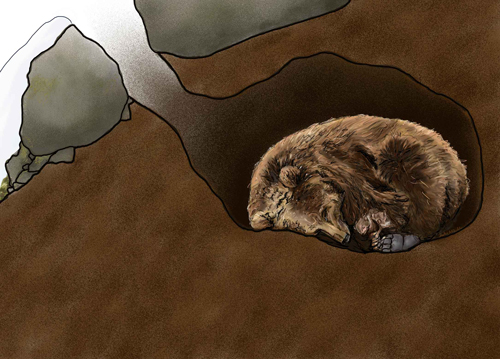
One adaptation that has evolved in some mammals is hibernation. Hibernation is a state of dormancy that allows animals to avoid periods of famine. It takes many forms in mammals, but is particularly remarkable in bears.
In the Katmai region, most bears go to their den and begin hibernation in October and November. Hibernation in bears is most likely triggered by a shortage of high calorie food as well as hormonal changes. After a summer and fall spent gorging on food, a bear’s physiology and metabolism shifts in rather incredible ways to help them survive several months without food or water.
When hibernating, a bear’s body temperature remains above 88˚F (31°C), not much lower than their normal body temperature of 100˚F (37.7°C). This is unlike other hibernating mammals such as ground squirrels whose body temperature drops close to freezing. A bear’s heart and respiratory rates, however, drop dramatically. They average only 1 breath per minute with a heart rate of 8-10 beats per minute in hibernation.
They still need to burn many calories per day while hibernating—sometimes more than 4000 calories per day. When they emerge from their dens in the spring, bears have lost up to 33% of their body weight. Lactating females can lose even more weight.
Surviving a winter without food or water requires fuel, and a bear fuels its body on the fat reserves it acquired during the previous summer and fall. Bears do not eat, drink, urinate, or defecate while in the den. Fat is metabolized to produce water and food, but instead of defecating or urinating to eliminate waste, bears recycle it. Their kidneys shut down almost completely and urea, a major component of urine, is recycled into proteins that maintain a bear’s muscle mass and organ tissues. Without the ability to recycle urea, ammonia would build up to toxic levels and poison the animal. Since they are living off of their stored body fat, bears also have very high levels of cholesterol in their blood.
Remarkably, healthy bears emerge from hibernation in the spring without losing muscle mass and bone density, or suffering from hardening of the arteries. Can the abilities of a hibernating bear help people in the future?
Perhaps. If we can unlock the physiological secrets of a hibernating bear, then we may be able to find new ways to treat kidney, heart, and bone diseases. We also might be able to more safely send humans on long distance space expeditions if we can find a way to hibernate like a bear.
In the depths of winter, when Katmai’s landscape is covered in snow and ice and the wind is howling fiercely, bears are nestled snug in their dens and sleep soundly. They feel no thirst or hunger at this time. Bears are survivors with a very special adaptation—hibernation—that allows them to survive harsh wintertime conditions and famine remarkably well.
